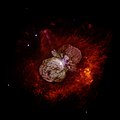پرونده:Eta Carinae.jpg
ظاهر

اندازهٔ این پیشنمایش: ۶۰۰ × ۵۹۹ پیکسل. کیفیتهای دیگر: ۲۴۰ × ۲۴۰ پیکسل | ۴۸۰ × ۴۸۰ پیکسل | ۷۶۹ × ۷۶۸ پیکسل | ۱٬۰۲۵ × ۱٬۰۲۴ پیکسل | ۲٬۰۱۵ × ۲٬۰۱۳ پیکسل.
پروندهٔ اصلی (۲٬۰۱۵ × ۲٬۰۱۳ پیکسل، اندازهٔ پرونده: ۱۶۳ کیلوبایت، نوع MIME پرونده: image/jpeg)
تاریخچهٔ پرونده
روی تاریخ/زمانها کلیک کنید تا نسخهٔ مربوط به آن هنگام را ببینید.
| تاریخ/زمان | بندانگشتی | ابعاد | کاربر | توضیح | |
|---|---|---|---|---|---|
| کنونی | ۱۸ دسامبر ۲۰۱۷، ساعت ۰۹:۴۱ |  | ۲٬۰۱۵ در ۲٬۰۱۳ (۱۶۳ کیلوبایت) | The NMI User | Reverted to version as of 14:14, 1 May 2008 (UTC) |
| ۱۳ مارس ۲۰۱۷، ساعت ۱۴:۴۵ |  | ۳٬۰۰۰ در ۲٬۹۹۸ (۱٫۱۸ مگابایت) | Leogorgon | larger file size | |
| ۱ مهٔ ۲۰۰۸، ساعت ۱۴:۱۴ |  | ۲٬۰۱۵ در ۲٬۰۱۳ (۱۶۳ کیلوبایت) | Vol de nuit | {{Information |Description=(NASA News Release) A huge, billowing pair of gas and dust clouds are captured in this stunning NASA Hubble Space Telescope image of the supermassive star Eta Carinae. Using a combination of image processing techniques (ditheri |
کاربرد پرونده
این پرونده در هیچ صفحهای به کار نرفته است.
کاربرد سراسری پرونده
ویکیهای دیگر زیر از این پرونده استفاده میکنند:
- کاربرد در da.wikipedia.org
- کاربرد در en.wikipedia.org
- Star
- Eta Carinae
- Wikipedia:Selected anniversaries/March 11
- Wikipedia:Today's featured article/March 2017
- Wikipedia:WikiProject Wikipack Africa Content/Wikipedia:Showcase
- Wikipedia:WikiProject WikiFundi Content/Eta Carinae
- Wikipedia:Today's featured article/requests/Eta Carinae
- Wikipedia:Today's featured article/March 12, 2017
- Wikipedia:Main Page history/2017 March 12
- Wikipedia:WikiProject WikiFundi Content/Wikipedia:Showcase
- Wikipedia:Main Page history/2022 March 11
- Wikipedia:Main Page history/2022 March 11b
- Wikipedia:Main Page history/2023 March 11
- Wikipedia:Main Page history/2023 March 11b
- User:2003 LN6/sandbox/Eta Carinae variable
- List of luminous blue variable stars
- کاربرد در en.wikiversity.org
- User:Marshallsumter/Radiation astronomy2/Visuals
- User:Marshallsumter/Radiation astronomy2/Violets
- Stars/Astronomy
- User:Marshallsumter/Radiation astronomy2/Violets/Quiz
- Stars/Sun/Astronomy/Quiz
- User:Marshallsumter/Radiation astronomy/Courses/Principles/Hourly 2
- User:Marshallsumter/Radiation astronomy/Courses/Principles/Final quiz
- Draft:Original research/Io/Quiz
- Titan/Quiz
- Stars/Solar systems/Quiz
- Moon/Quiz
- Earth/Quiz
- User:Marshallsumter/Radiation astronomy/Colors/Quiz
- Volcanoes/Io/Quiz
- Stars/Violets
- User:Marshallsumter/Radiation astronomy2/Stars
- Stars/Violets/Quiz
- کاربرد در es.wikipedia.org
- کاربرد در fr.wikipedia.org
- کاربرد در hi.wikipedia.org
- کاربرد در it.wikibooks.org
- کاربرد در la.wikipedia.org
- کاربرد در mk.wikipedia.org
- کاربرد در ms.wikipedia.org
- کاربرد در my.wikipedia.org
- کاربرد در oc.wikipedia.org
- کاربرد در ru.wikipedia.org
- کاربرد در sk.wikipedia.org
- کاربرد در sr.wikipedia.org
- کاربرد در th.wikipedia.org
نمایش استفادههای سراسری از این پرونده.

